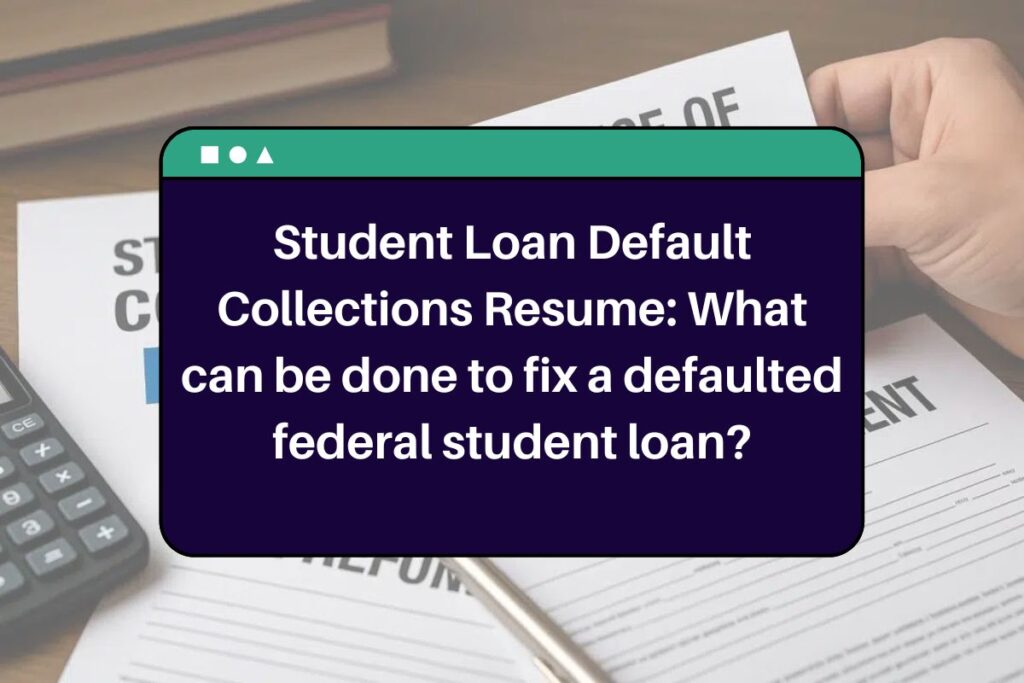Federal student loan collections are scheduled to officially resume on May 5, 2025, following a five-year halt that started during the COVID-19 epidemic. The resumption of severe government debt recovery measures, such as wage garnishment and tax refund seizures, is a result of this judgment, which impacts millions of borrowers whose loans have gone into default.
Understanding what this means for your financial future and your alternatives to prevent more penalties is crucial if you are formally in default or behind on payments. A borrower may experience all of the major consequences of student loan default at once. Payroll garnishments, tax refunds, and a portion of Social Security checks can all be withheld by the government.
It becomes harder to rent an apartment, buy a home, or get employment when credit ratings fall. In order to return to school or access loan relief options, borrowers are not eligible for additional student loans. Among the possible expenses are court and collection fees. Immediately take action if you’re in default. The goal is to limit the harm as much as possible.
Student loan default collections resume
Currently, over 5 million borrowers are in default, which is defined by the federal government as not making a payment on a federal student loan for longer than 270 days. Four million more debtors are also in risk of failing if they do not take immediate action. They have been behind on their payments for 91 to 180 days. The definition of default and the methods by which the government collects unpaid student loans.
Your loan has been referred for collections and is no longer in good standing if you are in default. Without a court order, the federal government can now utilize involuntary collection methods to get the money back. Your credit might be severely harmed by defaulting as well. Collections action and missed payments are reported to credit bureaus, which can harm your credit score over time and make it harder for you to get a mortgage, auto loan, or even a rental apartment.
Who is impacted right now?
Early in May, collections would resume for almost five million borrowers, according to the government. The only borrowers affected at the moment, according to experts, are those whose student loans were already past due when the epidemic payment hold started and are still past due. If you haven’t resumed your student loan payments since the end of the pandemic hiatus or have fallen a few months behind, you aren’t affected yet. Your defaulted may be reported to the credit bureaus if it is 90 days or more past due.
After missing payments for 270 days, a federal student loan defaults. In default accounts will start to default in late June or early July. By that time, over 1 in 4 borrowers with federal student loans, or about 10 million borrowers, might be in default, according to the Education Department.

Do you have doubts about if this is true for you? Log in to your student aid.gov account. You will see a new banner that says your student loans are in default and this will direct you to the loan servicer for federal student loans that have defaulted, the DRG.
Before transferring your debt to TOP, the ED must notify you of your default within 60 days. Your government payments, such as tax refunds, Social Security checks, and civilian government pensions, may then start to be withheld by the Treasury Department. It’s possible that your non-government company will have to provide your loan holder up to 15% of your earnings.
2 main ways out of default
Rehabilitation: You and your loan holder agree that you will make nine consecutive on-time monthly payments in ten months. Typically, the payment amount is determined by your family size and income. Typically, collection expenses under rehabilitation are less than those related to consolidation. Your credit report will no longer show the default line, but any late or missed payments made before the default will still be recorded.
Consolidation: The process, also which requires consolidating several loans into one federal loan, usually takes around sixty days, and you might have to make a few on-time payments before you can do so. For seven years, the default mark will be visible on your credit report.
Consolidation and rehabilitation are both one-time opportunities. You have very few choices for getting out of default if you have previously consolidated and rehabilitated and you are locked in a cycle of defaulting.
What can be done to fix a defaulted federal student loan?
- Before garnishments start later this summer, there is still time for you to take action if you are one of the millions of borrowers affected. Emails with instructions on how to settle their loans and prevent additional penalties will be sent to impacted borrowers by the Department of Education’s Default Resolution Group.
- Among the best ways to move forward is through loan rehabilitation. During ten consecutive months, nine timely and reasonably priced monthly payments must be made. Your credit history is cleared of the default status and collection attempts are halted upon completion.
- Debt consolidation is an additional option that involves combining your past-due debt into a new Direct Consolidation Loan. You must agree to pay back the new loan using an income-driven repayment plan, which adjusts your monthly payments according to your family size and income.
| Official Website | Click Here |
| Homepage | UniversityPressClub.Com |

